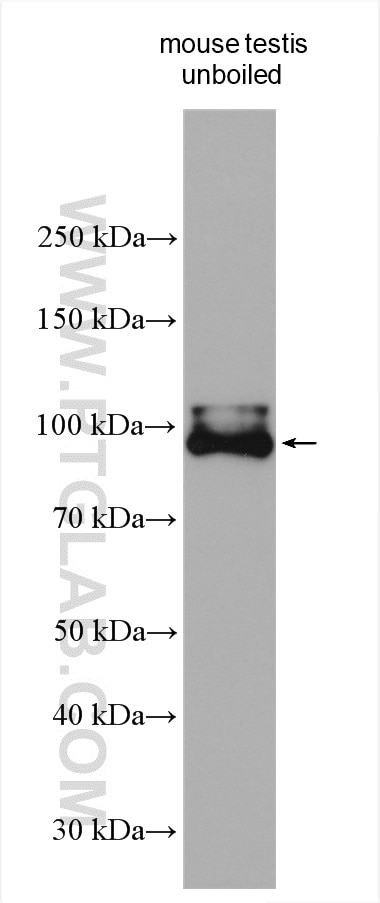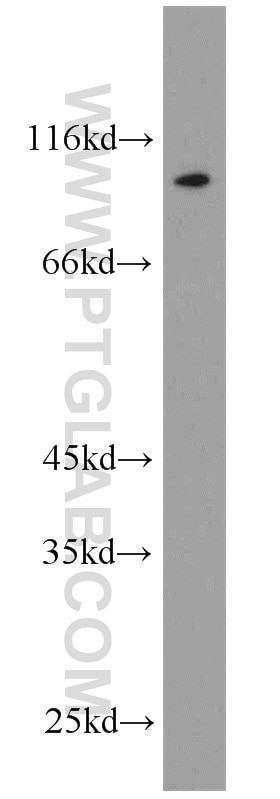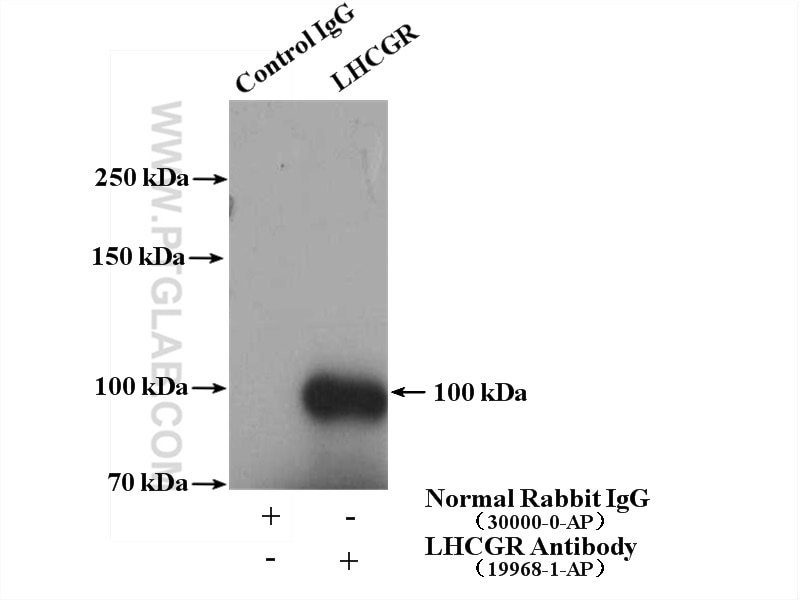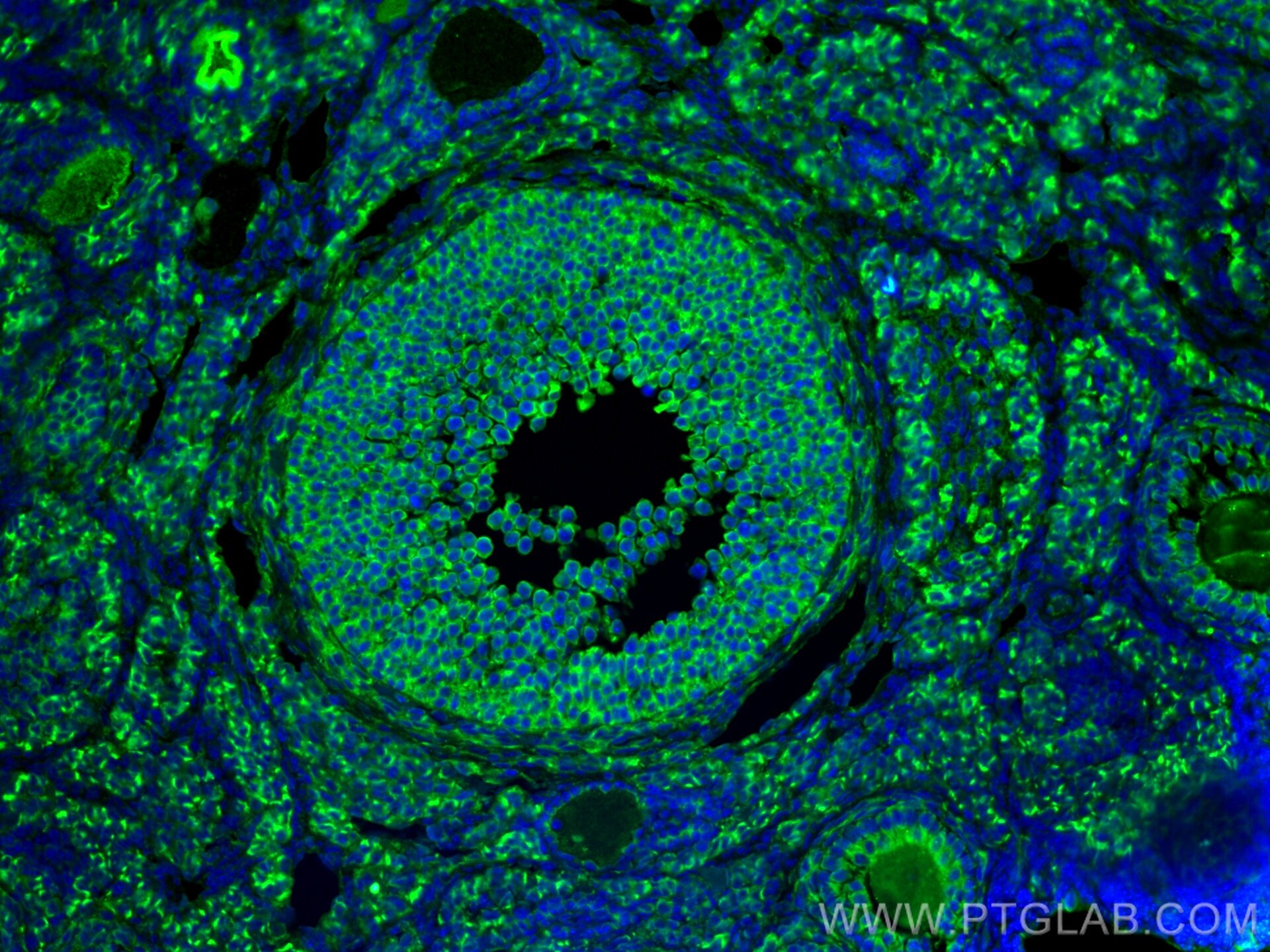- Featured Product
- KD/KO Validated
LHCGR Polyklonaler Antikörper
LHCGR Polyklonal Antikörper für WB, IF-P, IP, ELISA
Wirt / Isotyp
Kaninchen / IgG
Getestete Reaktivität
human, Maus, Ratte und mehr (1)
Anwendung
WB, IHC, IF-P, IP, ELISA
Konjugation
Unkonjugiert
Kat-Nr. : 19968-1-AP
Synonyme
Geprüfte Anwendungen
| Erfolgreiche Detektion in WB | ungekochtes Maushodengewebe, Maus-Eierstockgewebe |
| Erfolgreiche IP | Maushodengewebe |
| Erfolgreiche Detektion in IF-P | Maus-Eierstockgewebe |
Empfohlene Verdünnung
| Anwendung | Verdünnung |
|---|---|
| Western Blot (WB) | WB : 1:500-1:3000 |
| Immunpräzipitation (IP) | IP : 0.5-4.0 ug for 1.0-3.0 mg of total protein lysate |
| Immunfluoreszenz (IF)-P | IF-P : 1:50-1:500 |
| It is recommended that this reagent should be titrated in each testing system to obtain optimal results. | |
| Sample-dependent, check data in validation data gallery | |
Veröffentlichte Anwendungen
| KD/KO | See 2 publications below |
| WB | See 33 publications below |
| IHC | See 5 publications below |
Produktinformation
19968-1-AP bindet in WB, IHC, IF-P, IP, ELISA LHCGR und zeigt Reaktivität mit human, Maus, Ratten
| Getestete Reaktivität | human, Maus, Ratte |
| In Publikationen genannte Reaktivität | human, Hausschwein, Maus, Ratte |
| Wirt / Isotyp | Kaninchen / IgG |
| Klonalität | Polyklonal |
| Typ | Antikörper |
| Immunogen | Peptid |
| Vollständiger Name | LHCGR |
| Berechnetes Molekulargewicht | 79 kDa |
| Beobachtetes Molekulargewicht | 90-100 kDa |
| GenBank-Zugangsnummer | NM_000233 |
| Gene symbol | LHCGR |
| Gene ID (NCBI) | 3973 |
| Konjugation | Unkonjugiert |
| Form | Liquid |
| Reinigungsmethode | Antigen-Affinitätsreinigung |
| Lagerungspuffer | PBS with 0.02% sodium azide and 50% glycerol |
| Lagerungsbedingungen | Bei -20°C lagern. Nach dem Versand ein Jahr lang stabil Aliquotieren ist bei -20oC Lagerung nicht notwendig. 20ul Größen enthalten 0,1% BSA. |
Hintergrundinformationen
Lutropin-choriogonadotropic hormone receptor (LHCGR, also known as LHR or LSHR) belongs to the rhodopsin-like family of G protein-coupled receptors (GPCRs). It plays a crucial role in the regulation of gonadal functions by stimulating steroidogenesis in response to luteinizing hormone (LH) or hCG (PMID: 15866423). Mutations in the LHCGR gene result in familial male-limited precocious puberty, Leydig cell hypoplasia, and empty follicle syndrome (PMID: 30711030). LHCGR protein consists of 699 amino acids with a calculated molecular weight of 79 kDa. Due to massive glycosylation, the molecular mass of the mature LHCGR is higher (85-100 kDa) than the predicted molecular protein mass of 79 kDa (PMID: 23686864; 15866423; 29075189; 15969756).
Protokolle
| PRODUKTSPEZIFISCHE PROTOKOLLE | |
|---|---|
| WB protocol for LHCGR antibody 19968-1-AP | Protokoll herunterladen |
| IF protocol for LHCGR antibody 19968-1-AP | Protokoll herunterladen |
| IP protocol for LHCGR antibody 19968-1-AP | Protokoll herunterladen |
| STANDARD-PROTOKOLLE | |
|---|---|
| Klicken Sie hier, um unsere Standardprotokolle anzuzeigen |
Publikationen
| Species | Application | Title |
|---|---|---|
J Hazard Mater GRP78/IRE1 and cGAS/STING pathway crosstalk through CHOP facilitates iodoacetic acid-mediated testosterone decline | ||
Environ Pollut Chronic exposure to polystyrene microplastics induced LHR reduction and decreased testosterone levels through NF-κB pathway | ||
Part Fibre Toxicol Chronic exposure to polystyrene microplastics induced male reproductive toxicity and decreased testosterone levels via the LH-mediated LHR/cAMP/PKA/StAR pathway. | ||
Int J Nanomedicine La2O3 Nanoparticles Induce Reproductive Toxicity Mediated by the Nrf-2/ARE Signaling Pathway in Kunming Mice. | ||
Biol Res Unraveling the impact of hyperleptinemia on female reproduction: insights from transgenic pig model | ||
Reprod Biol Endocrinol miR-6881-3p contributes to diminished ovarian reserve by regulating granulosa cell apoptosis by targeting SMAD4 |





